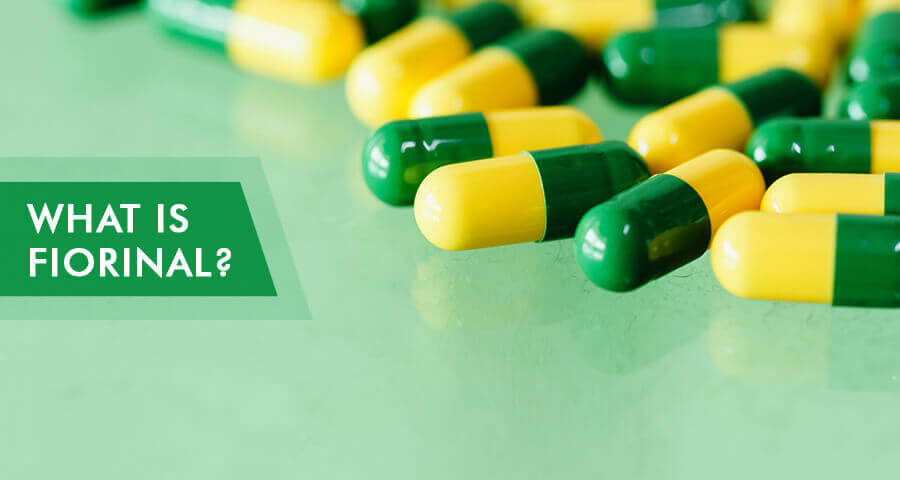
Fiorinal is a prescription medication indicated for the management of the collection of symptoms associated with Tension-Type Headache (TTH). This medicine combines the pharmacological properties of Aspirin, Caffeine, Butalbital, as well as Codeine in certain formulations to achieve strong abortive and analgesic effects. However, containing arguably two of the most habit-forming and addictive drugs, Butalbital a barbiturate, and Codeine an opioid, the risk of Fiorinal addiction and abuse is substantial.
Table Of Contents:
So much so that those formulations that contain Fiorinal with Codeine are issued with a BlackBox warning, cautioning users of the aforementioned risks as well as the dangers of overdose and death. What is even more interesting is the fact that in the cases of Fiorinal abuse, a Medication Overuse Headache with persistent symptoms may develop in conjunction with a Tension-Type Headache (TTH). This creates a loop in which the very medicine causes the headache symptoms it is trying to treat, which itself is a recipe for chronic misuse and addiction. As such, this article will endeavor to discuss the major points of interest relating to the use, misuse, addiction treatment, and alternatives to the medication Fiorinal.

More About Barbiturates:
More About Painkillers:
What is Fiorinal?
As already touched upon in the introduction, Fiorinal is a medication that combines three to four different pharmacological agents in order to achieve strong relief from the symptoms of Tension-Type Headaches (TTH). If one had to classify this medication, it could be said that it is an abortive drug with potent analgesic, anxiolytic, and spasmolytic properties. As for the mechanism of its action (MOA), it is resultant from the “sum of its parts”, and as such, to see the whole picture and understand how it works, the MOAs of its individual components (Aspirin, Caffeine, Butalbital, Codeine) must be discussed individually.
- Aspirin, also known as Acetylsalicylic Acid, is a nonsteroidal anti-inflammatory drug (NSAID) that has primarily anti-inflammatory, analgesic, and anti-platelet effects.
- Caffeine is a methylxanthine compound and a Central nervous system (CNS) stimulant. It has both anti-inflammatory and vasodilatory effects.
- Butalbital is a barbiturate that potentiates the effects of the inhibitory neurotransmitter gamma-Aminobutyric acid (GABA). Through this, Butalbital mediates a range of effects such as sedation, hypnosis, anxiolysis, and muscle relaxation.
- Codeine is a natural opioid that is converted to Morphine through metabolism. It acts at the μ/mu-opioid receptors mediating effects such as analgesia, sedation, respiratory depression, slowed gastrointestinal transit, and modulation of various neurotransmitter release within the central nervous system (CNS).
Therefore, the mechanism of action includes analgesia, anxiolysis, and smooth muscle relaxation produced through the combined pharmacological properties of Aspirin, Caffeine, Butalbital, and Codeine.
Fiorinal and Fiorinal with Codeine under the United States Controlled Substances Act (CSA) are classified as Schedule III controlled substances, defined as having potential for abuse leading to moderate or low physical dependence or high psychological dependence.
The actual statistics on Fiorinal addiction or abuse are unknown. However, Butalbital a barbiturate, and Codeine an opioid have a long history of misuse.
Indications For Fiorinal Use
Fiorinal is indicated for the abortive management of the collection of symptoms and signs associated with Tension-Type Headaches (TTH). Although incompletely understood, it is believed that the cause of Tension-Type Headaches is multifactorial, and involves an interplay between emotional stress, anxiety, muscle spasms, and depressive illnesses. As such, the effects of this medication, such as analgesia, anxiolysis, and spasmolysis, can be very helpful in treating TTHs.
However, the Use of This Medication for the Treatment of Tension-Type Headaches Is Only Justified When:
- Alternative non-barbiturate/non-opioid medications cannot be used
- Alternative non-barbiturate/non-opioid analgesics have not yielded sufficient analgesia
Furthermore, the duration of use for this medication is dependent on highly individual factors and the determination regarding the length of administration should be made by a professional healthcare provider. But, as a general rule, it is best to limit the use of this drug for the shortest possible duration to prevent the development of physiologic dependence and possible withdrawal upon discontinuation.
Fiorinal For Migraines
This medication can be used “off-label” for the abortive treatment of migraine headaches. When prescribed for migraines, the user is meant only to take the medication when they feel a migraine starting. It is imperative to note that this medication is not meant to be used prophylactically to prevent the onset of migraines.
Fiorinal Generic Names
The combination of Aspirin, Caffeine, Butalbital with or without Codeine is most frequently seen as Fiorinal, which is a brand medication marketed by Allergan, Inc. However, there are numerous Fiorinal generic formulations containing a combination of Aspirin, Caffeine, and Butalbital. Other brand name preparations one may come across include Ascomp with Codeine, Anolor 300, Dolgic LQ, Esgic, Ezol, Geone, and Margesic to name a few.
Fiorinal Dosage Strength, Formulations, And Ingredients
Fiorinal ingredients are broken down into active and inactive ones.
For most patients, active Fiorinal drugs are the most important to know. They include the combination of Aspirin, Caffeine, Butalbital, and with certain formulations, Codeine Phosphate.
This medicine is supplied in a capsule that contains 50mg dose of Butalbital, 325mg dose of Aspirin, 40mg dose of Caffeine, and if included, 30mg dose of Codeine Phosphate.
The medicine capsule of Fiorinal with Codeine has a blue cap imprinted in red with “FIORINAL” and “CODEINE”. The body of the capsule is yellow and is imprinted in red with “WATSON 965”.
The medicine capsule of Fiorinal without Codeine has a dark green cap and a light green body both imprinted with “FIORINAL 955” in red letters.

Fiorinal Side Effects And Warnings
Since Fiorinal contains not one but a combination of three to four individual drugs, the list of possible side effects and warnings is immense. Aspirin, Caffeine, Butalbital, and Codeine each have their own spectrum of side effects and warnings, and the discussion of these individually in a single article is not feasible and offers no practical benefit to the reader. As such, below are offered the most common side effects and warnings associated with the COMBINED use of these agents.
For more information, read about codeine side effects and overdose.
Frequent Side Effects
The frequently encountered side effects are defined as ones that have occurred in ≥1% of the individuals using this medication. The following are the most frequently encountered side effects encountered:
- Drowsiness
- Dizziness
- Lightheadedness
- Abdominal pain
- Nausea
Drowsiness, syncope, abdominal pain, and nausea in conjunction with weight loss and hypotension can also be a side effect of Adrenal Insufficiency, which can be a rare but life-threatening complication of this medication use.
Infrequent Side Effects
The infrequently encountered side effects are defined as ones that have occurred in <1% of the individuals using this medication. The Following Are Some of the Infrequently Encountered Side Effects:
- Central Nervous System: headache, tingling, agitation, fainting, heavy eyelids, high energy, hot spells, numbness, and sluggishness
- Autonomic Nervous System: Dry mouth and hyperhidrosis
- Gastrointestinal: vomiting, dysphagia, gastroesophageal reflux
- Cardiovascular: tachycardia
- Musculoskeletal: leg pain, muscle fatigue
- Genitourinary: diuresis
- Miscellaneous: itching, fever, otitis, nasal congestion, ringing in the ears
These side effects can be increased in severity and encountered in greater frequency if the dose of medication taken is increased or when its use is combined with other CNS depressant drugs. In other words, when acute intoxication or overdose on Fiorinal occurs.
Most Important Warnings and Precautions
There are some common warnings, and precautions individuals should keep in mind before starting Fiorinal, as they can be life-threatening. These Warnings and Precautions Include:
- Life-threatening respiratory depression when used in conjunction with other CNS depressants, used in children <12 years old, or when used in those patients who have chronic respiratory diseases;
- Development of Serotonin when combined with Serotonergic drugs such as antidepressants and MAOIsPosition-dependent hypotension and syncope/fainting;
- Allergic reactions and anaphylactic reactions
- Risk of bleeding
- Constipation and ileus
- Numerous drug-to-drug interactions
As always, this is not an exhaustive list of the possible side effects and warnings that can be associated with use, and numerous individual factors affect the emergency of these adverse reactions. It is imperative that a primary healthcare provider be consulted for detailed information about the possible side effects this medication may have on a specific individual.
Outside of the possible life-threatening complications listed above in the section on Side Effects and Warning, one other seriously concerning danger of use and abuse of this medication includes the development of tolerance and dependence.
Fiorinal Alternatives
Numerous non-opioid and non-barbiturate medications exist for the treatment of headaches. These could include Triptans, Geptans, Ergotamines, various NSAIDs, Monoclonal Antibodies, Beta-blockers, Antidepressants, and various other medications. For example, a very efficacious prophylactic medication used for dealing with chronic Tension-type headaches is Amitriptyline (Elavil). Amitriptyline is a tricyclic antidepressant (TCA) that has less tendency for causing dependency and addiction in comparison to Fiorinal. However, since TCAs affect multiple neurotransmitters within our central nervous systems, they too have their own side effects. One of the most intolerable and frequent side effects of TCAs include anticholinergic effects such as dry mouth and eyes, blurred vision, hypotension, and weight gain. These adverse effects can limit the efficacy of Amitriptyline in some patients. Thus choosing the right treatment for a headache can be quite difficult. It involves carefully weighing the benefits and drawbacks of multiple medications and choosing the one that is right for a specific patient. As such this should only be done through a consultation with a healthcare provider.
Fiorinal vs Fioricet
Fiorinal drugs offer a unique combination that does not have a true alternative outside of Fioricet. Fiorinal and Fioricet are two almost similar medications with the same mechanisms of action and indications. When comparing Fiorinal vs Fioricet, it can be difficult for patients to spot a difference. The primary difference between Fiorinal vs Fioricet lies in which non-opioid or non-barbiturate pain reliever they use in their formula. As such, the difference between Fiorinal vs Fioricet is that the former uses aspirin for pain relief, and the latter uses acetaminophen.
Yet, another difference between Fiorinal vs Fioricet is that the former is classified as a controlled substance by the DEA, while the latter is not. This is related to the fact that the use of acetaminophen reduces the active dose of Butalbital to very low doses which practically negates the potential risk of dependence.
Fiorinal Half-Life And How Long Does It Stay In The System
Below are the half-lives of the Fiorinal drugs. The half-life of these medications governs the duration of time patients will experience both the therapeutic effects as well as the adverse side effects. However, it is important to remember that individual factors can produce variability among these half-lives.
| Aspirin | The half-life of Aspirin is 13 – 19 minutes
The half-life of Acetylsalicylic Acid is 3.5 – 4.5 hours |
| Caffeine | ~9 hours |
| Butalbital | The mean half-life is ~35 hours |
| Codeine | ~3 hours |
Although Aspirin and Caffeine do have metabolites that are detectable in biological samples, they are never tested for as neither of these substances is controlled. However, Butalbital and Codeine being a barbiturate and an opioid are heavily tested for in routine drug panels. Below are offered the duration of detectability of both Codeine and Butalbital in the biologic samples(urine, saliva, hair) they’re most commonly tested with.
| BUTALBITAL | Duration of Detectability |
| Urine | 3-7 days |
| Saliva | 2-3 days |
| Hair | Up to 90 days |
| CODEINE | Duration of Detectability |
| Urine | 24-48 hours, 1 week in chronic users |
| Saliva | 21 hours |
| Hair | 10 weeks |
It is always important to keep in mind that individual variations such as age, gender, weight, genetics, concurrent illnesses, and duration of use can all affect these durations, and as such these time-frames are subject to individual variability.
Fiorinal Addiction and Abuse
This medication whether formulated with or without Codeine has a strong liability for abuse and addiction as well as for the development of tolerance and dependence. Whether the liability is attributed to Butalbital or Codeine, it is undeniably there.
What Makes Fiorinal Addiction And Abuse so Frequent?
The actual statistics on Fiorinal addiction or abuse are unknown. However, Butalbital a barbiturate, and Codeine an opioid have a long history of misuse. Barbiturates are prone to the development of physiological and psychological tolerance, during which individuals need ever-increasing doses of the drug to achieve the same degree of effect. This could be one reason why Fiorinal abuse and possible overdose may occur. Furthermore, Opioids have a long history and a strong liability of abuse and addiction, and Fiorinal Addiction can occur both at recommended therapeutic doses as well as when abused. Although not nearly as serious, addiction to caffeine may also occur and could be a small contributing factor to the overall addiction liability of this medication.
Who Is Most At Risk Of Fiorinal Abuse and Addiction?
Once again this information relating specifically to Fiorinal does not exist. However, there are ubiquitous factors that influence a person’s drug-using behavior. Specifically, the factors that influence the risk of barbiturate and opioid abuse and addiction could be applied and be stated as the same ones for Fiorinal abuse and addiction.
- Personal or family history of substance abuse
- Prior history of drug
- Poverty
- Unemployment
- Young age
- History of illicit activity
- Heavy tobacco or marijuana use
- History of mental illness
- Stressful circumstances
It is important to keep in mind that this is not an exhaustive list of the risk factor that can predispose to addiction. There are numerous individual factors that may even be unique to a person and can predispose them to substance abuse and addiction.

Fiorinal Abuse And Addiction Signs and Symptoms
As with all substances of abuse, there can be tell-tale clues that could point to the presence of abuse and addiction. Although at times subtle, it is important to recognize these signs and symptoms as this is the first step in getting a loved one the help they need.
Behavioral and Physical Signs
Behavioral signs although not specific characterize most substances of abuse and could include but are not limited to:
- A strong desire to use the medication;
- Difficulties with controlling the use of this medication;
- Persistence with the use of this medication despite negative physical, social and psychological consequences;
- Higher priority is given to the use of this medication than to other social or occupational obligations;
- The emergence of “Drug-seeking” behavior manifested by prescription tampering, “Doctor shopping” or refusal to submit to medical examinations and tests.
The physical signs of Fiorinal abuse and addiction will mimic its side effects. However, these may be increased in severity due to taking higher doses. As such, patients will experience exaggerated levels of drowsiness, dizziness, lightheadedness, abdominal pain, and nausea.
Once again this is not an exhaustive compilation of the behavioral and physical signs and symptoms. Rather, a list of the most commonly encountered behavioral signs of abuse and addiction. As such, it is important to keep in mind that an individual suffering from substance abuse may have other signs and symptoms outside of the ones listed above.
Possible Dangers Of Fiorinal Use And Abuse: Fiorinal Withdrawal
Outside of the possible life-threatening complications listed above in the section on Side Effects and Warning, one other seriously concerning the danger of use and abuse of this medication includes the development of tolerance and dependence. This phenomenon can occur during proper treatment for an extended period of time as well as during abuse, and the particular danger is associated with the potential development of a life-threatening withdrawal symptom if Fiorinal is discontinued rapidly. The symptoms of withdrawal can be particularly dangerous as they are a combination of Opioid and Barbiturate withdrawal symptoms.
These Symptoms And Signs Could Include:
- Restlessness, Irritability, Anxiety
- Lacrimation, Rhinorrhea, Yawning
- Sweating, Chills
- Mydriasis
- Backache, Muscle pain, Joint pain
- Abdominal cramps, nausea, anorexia, vomiting, diarrhea
- Insomnia, nausea, anorexia, vomiting, diarrhea
- Tachycardia, Tachypnea, Hypertension
Symptoms of withdrawal can be serious and their severity is dependent on the duration and the dosage of medication use. Furthermore, withdrawal syndrome required inpatient management to provide symptomatic support and minimize the risk of life-threatening complications.
Fiorinal Addiction Treatment
Individuals with an addiction to Fiorinal have the possibility to be addicted to two separate drugs, Barbiturates, and Opioids. As such they require particular care.
As with all addiction treatment, the first step is always to achieve detoxification. Detoxification from this medication can be particularly dangerous due to the strong propensity for tolerance and dependency. Therefore, detox should be undertaken in an inpatient facility where a proper tapering regimen can be established and symptomatic support with other pharmaceuticals be provided if required. Following detoxification patients will benefit from psychological and emotional support through treatment options such as group therapy, cognitive-behavioral therapy, 12-step programs, or family counseling. These treatment modalities are intended to aid the patient after becoming sober and to promote long-term sobriety.
Frequently Asked Questions
Why Is Fiorinal A Controlled Substance?
Fiorinal is a controlled substance because of its constituent medications. Both Barbiturates(Butalbital) and Opioids(Codeine) are Scheduled controlled substances under the United States Controlled Substances Act (CSA).
Is Fiorinal A Narcotic?
A narcotic is defines as a substance that can produce pain relief or analgesia, state of sedation/sleep or narcosis, and have the liability for addiction or the physical dependence of the drug. Although, not a narcotic itself. Certain formulations of Fiorinal contain Codeine, which is designated as a narcotic, as it fulfills all of the aforementioned criteria.
Is Fiorinal An Opioid?
The term opioid describes all compounds, synthetic or natural, that work at opioid receptors within the central nervous systems (CNS). Although Fiorinal is not an opioid itself, certain formulations of it can contain an opioid. The opioid contained within this medication is Codeine, a drug that is metabolized to Morphine, the prototypical opioid.
Is Fiorinal An Opiate?
An opiate is a term used to refer to naturally derived opioids. As previously mentioned although not an opiate itself, certain formulations of Fiorinal do contain an opiate, Codeine. Since Fiorinal contains a combination of multiple drugs, it cannot be ascribed to a single drug classification. Rather, it is a unique medication that contains an NSAID, a Sedative-Hypnotic, a CNS Stimulant, as well as an Opioid.
Hope Without Commitment
Find the best treatment options. Call our free and confidential helpline
Most private insurances accepted
Find Drug Rehabilitation Centers Near You Anywhere In the US
Addiction Resource team has compiled an extensive list of the top drug rehabilitation facilities around the country. Use our locator tool to find the best centers near you.
Page Sources
- Allergan. (2021, April). DailyMed - FIORINAL- butalbital, aspirin, and caffeine capsule. Dailymed.Nlm.Nih.Gov https://dailymed.nlm.nih.gov/dailymed/drugInfo.cfm?setid=26f62036-2fec-4aa2-905b-e38bbd0fd3f5#leftmenu
- Elkind A. H. (1991). Drug abuse and headache. The Medical clinics of North America, 75(3), 717–732. https://doi.org/10.1016/s0025-7125(16)30445-x
- Richard Feeney (2016) Medication Overuse Headache Due to Butalbital, Acetaminophen, and Caffeine Tablets, Journal of Pain & Palliative Care Pharmacotherapy, 30:2, 148-149, DOI: 10.3109/15360288.2016.1167805
- Sands G. H. (1990). A protocol for butalbital, aspirin, and caffeine (BAC) detoxification in headache patients. Headache, 30(8), 491–496. https://doi.org/10.1111/j.1526-4610.1990.hed3008491.x
- Scher, A., Lipton, R., Stewart, W., & Bigal, M. (2010). Patterns of medication use by chronic and episodic headache sufferers in the general population: Results from the frequent headache epidemiology study. Cephalalgia, 30(3), 321–328. https://login.research4life.org/tacsgr1doi_org/10.1111/j.1468-2982.2009.01913.x
- Sinclair, A. J., Sturrock, A., Davies, B., & Matharu, M. (2015). Headache management: pharmacological approaches. Practical neurology, 15(6), 411–423. https://doi.org/10.1136/practneurol-2015-001167


 Reviewed by:
Reviewed by:  Written by:
Written by: 


 FindTreatment.gov
FindTreatment.gov